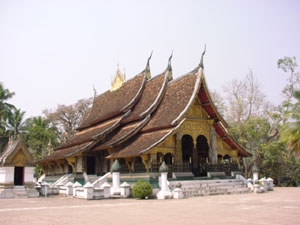![]()
| Laos | Luang Prabang | 2002.02.24 - 02.27 |
Asia's Best Preserved City
Under a decade ago, Luang Prabang was nearly isolated from outside influence. The rare traveler with special government permission could arrive by flight or boat. Life in Luang Prabang continued as it had for centuries.
5 years ago, the Lao government began promoting tourism, issuing a tourist visa to anyone. A road connecting Vientiane to Luang Prabang was built. And in an attempt to preserve the city despite heightened tourism, the government restricted growth. The result is skyrocketing inflation. Prices throughout the city are double or triple those listed in the newest travel guidebooks. Simple guesthouses are upgrading to modern facilities and increasing their prices further. The once common pedestrian jam of monks is now replaced by tourists. Still, as far as cities go, Luang Prabang is more laid back and unspoiled than most. Whether the ambiance continues, even with the city's UNESCO "World Heritage Site" classification, remains to be seen.
BUDDHIST TEMPLES
Luang Prabang is essentially a row of Buddhist temples, now interspersed
with expensive tourist restaurants and the occasional Internet Café.
Each temple has a unique feature described in any guidebook. The most
impressive, Wat Xieng Thong, is at the northernmost point in the city.
PAK OU CAVE
40 km north of Luang Prabang is Pak Ou Cave. A daytrip by boat or truck
is easy from Luang Prabang. Though guidebooks promote Pak Ou, we didn't
find it worthwhile.
GETTING THERE
Daily buses from cities north and south of Luang Prabang depart for
Luang Prabang in the morning. Like Vientiane, guesthouses in Luang
Prabang fill early. A mid-afternoon or earlier arrival is recommended.
 |
Reputed to be the most impressive temple in Luang Prabang, Wat Xieng Thong rests at the northern end of town at the confluence of the Mekong and Khan rivers. The sloped tiered roof is a common style of Lao Buddhist temples. |
 |
Young monks rhythmically bang drums and cymbals each afternoon at Wat That Luang. These boys know how to jam. |
Copyright © 2000-2002 Wes and Masami Heiser. All rights reserved.